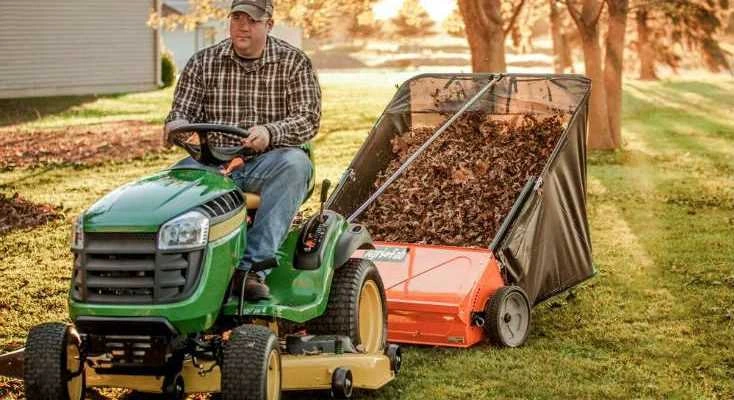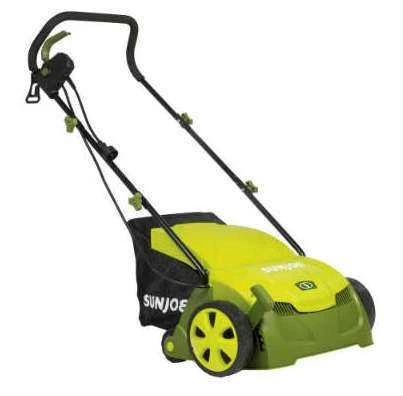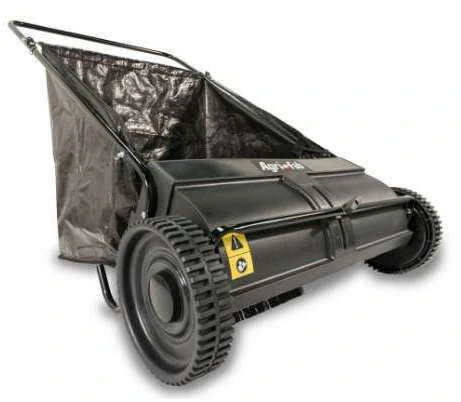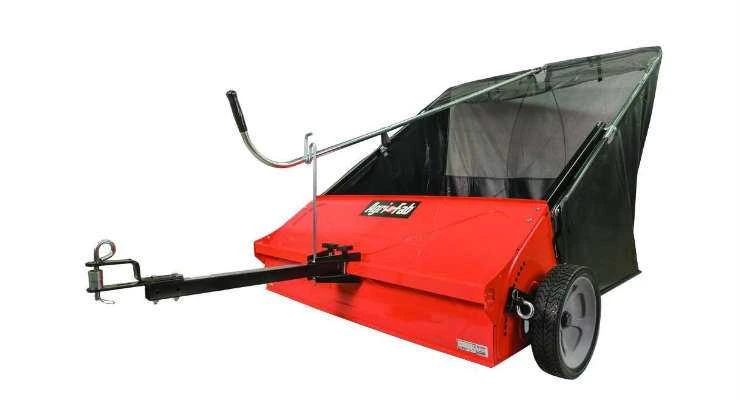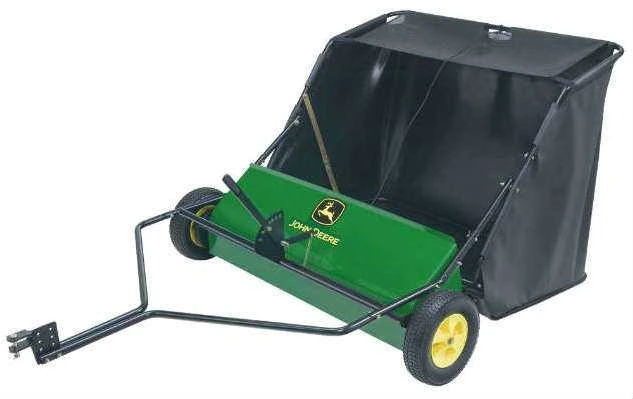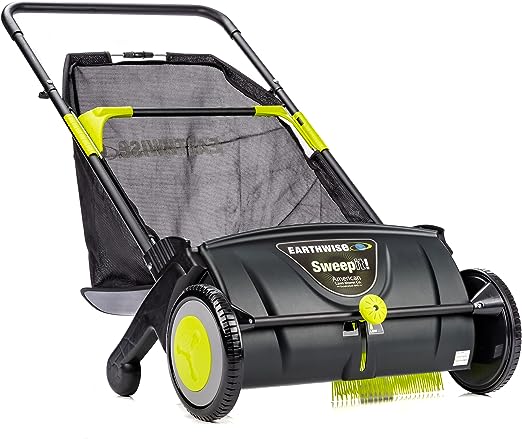Lawn maintenance is one of the necessary activities required from a homeowner. In order for us to enjoy a great looking lawn, we need to use the right tools to promote proper grass coverage and growth. One of the things that hamper this process is yard debris. This is where the best lawn sweeper and an electric dethatcher can come into play.
A yard sweeper uses brushes or tines to pick up loose grass clippings and fallen leaves from the lawn. It is also capable of lifting material that is matted into the soil. The best lawn sweeper will offer features that make this process effective and fast.
Thatch is essentially decaying organic matter, a dense mat of moss, grass clippings, stems, clumps, overcrowded grass roots, and lateral weed growth, or debris that accumulates on lawns over time, blocking the flow of water, oxygen, fertilizers, and vital nutrients.
This is where an electric lawn dethatcher comes into play, easing the task of promoting lawn health and reducing the manual effort required for cultivating a robust and thriving lawn.
Scarification or de-thatching of lawns or turf is a mechanical process whereby the surface and subsurface of the lawn, green, or sports pitch are rigorously abraded by penetrating metal blades, tines, or prongs (source).
In case of serious moss buildup on your lawn, it’s a good idea to use a good quality moss killer a few days before running through it with a lawn sweeper or electric dethatcher.
These tools allow us to maintain our yards without having to over-work ourselves with traditional hand tools like a leaf rake. What follows is a closer look at these devices, highlighting design elements and product features that make these tools a worthwhile investment. Five product reviews follow afterward.
Why Would You Need a Lawn Sweeper or Electric Dethatcher?
General Usage
A lawn sweeper is used to collect debris from a lawn. Grass clippings, fallen leaves, and even pine needles or small twigs can prevent sunlight from shining on the lawn as well as blocking oxygen and water. This can cause the grass to become discolored. Worst case, it can also cause the grass to die eventually, leaving a yard with bald spots.
A lawn sweeper collects the debris and prevents these issues from happening in the first place. The brushes that a lawn sweeper uses to collect materials are also safer to use on a lawn. A leaf rake can damage the grass as its prongs are dragged through the lawn. A lawn sweeper uses brushes that rotate at an even height and their bristles do not damage the roots on blades of grass.
A leaf sweeper is able to collect materials into a hopper. Even a mower that collects trimmings leaves behind tiny clippings that must be raked and bagged.
Lawn Sweeper vs Leaf Rake
The advantages a lawn sweeper has over a leaf rake boil down to convenience and ease of use. A rake requires a lot of work to use effectively, especially one heavy or matted lawn debris. A power dethatcher or lawn sweeper can clear the same materials without overworking arms and shoulders. Raking a lawn requires a minimum level of physical ability and fitness to use, while almost anyone who can walk is able to push a leaf sweeper.
Generally, the best leaf sweepers are effective, as they can collect debris faster than a leaf rake is able to. A rake may be able to collect dry clippings and leaves, but it takes multiple passes to gather these materials when they are wet. A leaf sweeper or dethatcher uses brushes to dig into the grass, allowing it to collect debris that is matted into the ground. It will often take more than one pass from a leaf rake to remove this same material.
Lawn Sweeper vs Leaf Blower
There are a few distinct ways in which a lawn sweeper is more advantageous than a leaf blower. The first category is in a lawn sweeper’s ability to pick up debris. While a leaf blower works well on lifting or moving around dry materials, it can struggle when attempting to lift or move wet organic matter and debris. The best lawn sweeper for leaves, on the other hand, is able to do both with wet grass clippings and those nasty leaves.
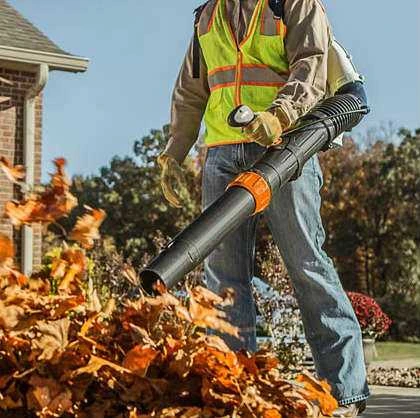
Next, a leaf blower will struggle with materials that are matted down or partially woven into the lawn. A lawn sweeper is able to dig into the grass with its brushes and pull the debris free. Those who use leaf blowers know all too well how easily a leaf blower will scatter any material that it can move. The lawn sweeper collects the debris into one area.
Another distinct advantage is in noise levels. Blowers are loud, producing decibel levels ranging into the mid-70s of dBA even at a distance of 50-feet. A lawn sweeper does not use a motor and runs silently.
Features to Consider of the Best Lawn Sweepers
A Push Lawn Sweeper or Electric Dethatcher
The push lawn sweeper requires the user to push it manually across the yard. While these units do not require a lot of muscle to use, the homeowner must be able to guide it across a lawn as they walk. As the wheels turn, gears activate small brushes along the bottom of the sweeper that collect debris from the grass. This material is collected in a bin that is then emptied after it fills up.
Pushed electric dethatchers are smaller than the tow-behind models and similar in size to an average lawn mower.
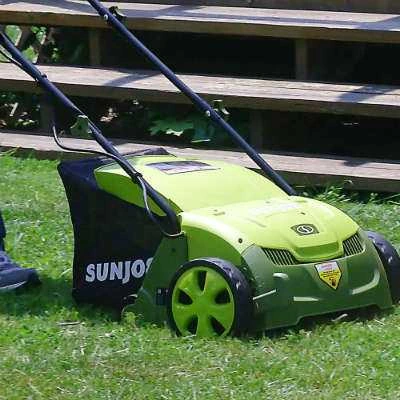
They are a great choice for use on smaller residential properties found in most urban settings. They can be used on medium-sized properties if the operator is capable of walking the entire area needing to be swept.
The Tow-behind Lawn Sweeper
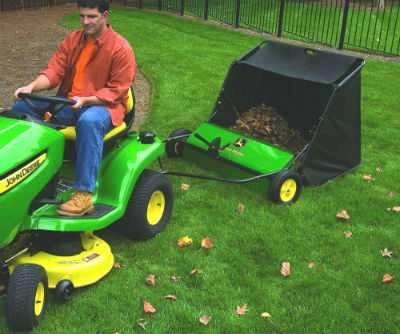
This style of lawn sweeper requires a ZTR mower, lawn tractor or a riding mower to use. It is attached to the back of these motorized tools and then pulled across the yard. They are capable of covering a larger swath with each pass and are capable of collecting more debris than a push sweeper is capable of before it needs to be emptied. As the tow-behind sweeper must be towed by a heavy tractor or mower, it is not as quiet as a manual or electric dethatcher model is.
These units are more costly than the push variety and are heavier as well. They are ideal for property owners who have larger front and back-yards. The tow-behind is often used in commercial settings with a lot of grass that needs to be swept.
Other Considerations Before Buying a Lawn Sweeper
Tires are an important feature, especially with push sweepers.
Height adjustments are important as well. Tine depth or cutting depth can usually be adjusted in steps which gives greater control in removing light or more serious thatch layers.
The size of the collection bin or bag can be a deciding factor between two models with similar design features. Stopping all the time to empty an undersized bag could be frustrating, while on the other hand, pushing an electric dethatcher with a huge heavy container full of debris might be too much for some.
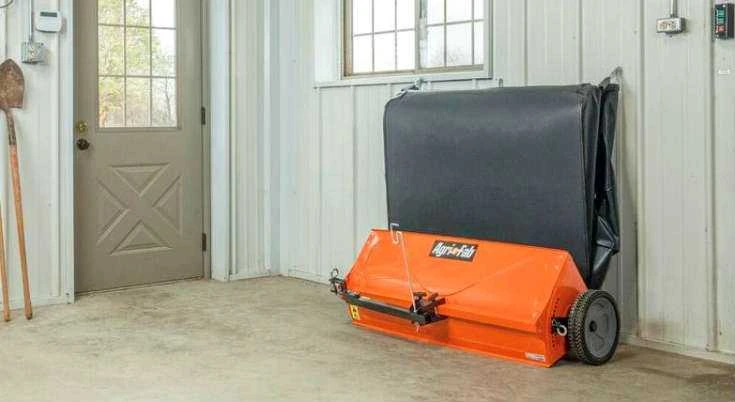
Storage is always lacking, therefore only choose a tow-behind lawn sweeper if you have the space for the increased storage needs. A push behind lawn sweeper is not bigger than a traditional mower and some have folding handles or similar storage savers.
Best Lawn Sweeper Reviews With/Without Electric Dethatcher
BLACK+DECKER BV6000 High Performance Blower/Vac/Mulcher
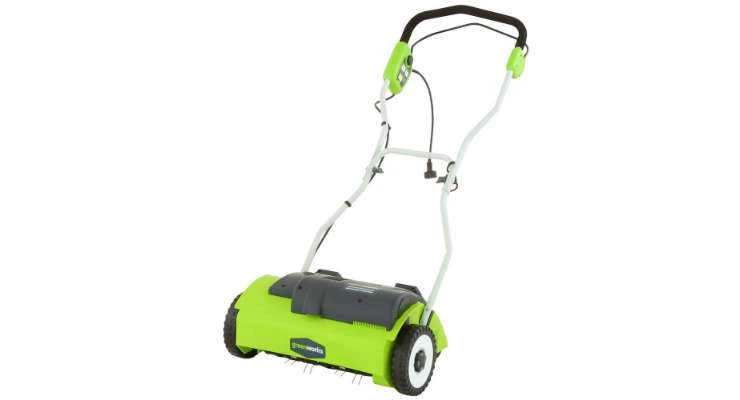
Pros
- The electric motor makes this unit easier to use
- A push button makes starting the motor easily
- It comes with a 4-year warranty
Cons
- The motor requires a heavier extension cord to prevent drops in power
14
Dethatching Path (inches)
29.5
Weight (lbs)
10
Motor (amp)
This corded electric dethatcher weighs 29.5 pounds and provides a 14-inch wide coverage with each pass. It uses padded grips to provide an ergonomic hold during use. This adjustable leaf sweeper is a nice feature for family members who vary in their height.
A 10-amp motor provides power and is turned on and off with the push of a button. The tines are made of stainless steel that will provide longevity. It can be adjusted to a height of one, three, and 10 mm from the ground. The manufacturer offers a four-year warranty on this product.
Agri-Fab 45-0218 Push Lawn Sweeper
Pros
- This model weighs less than similar sized push models
- It can be used as a dethatcher or a scarifier
- There are five height adjustment levels provided on this unit
Cons
- The width of the pattern is under 13-inches
- Its debris bin is smaller than similar sized models
12.6
Dethatching Path (inches)
23
Weight (lbs)
12
Motor (amp)
The first feature that stands out on this product is its minimal 23-pound weight. Shedding unneeded pounds will make this unit easier to push. The height of the tines (the “teeth of the dethatcher) is adjustable with five settings, offering more versatility than other models. The ability to change from a dethatcher to a scarifier allows for cutting at the root level.
A nice safety feature that is incorporated into the design is the safety switch, which may be important for users with younger children. It has four wheels that provide level control.
Agri-Fab Lawn Sweeper – Model 45-0218
Pros
- This sweeper provides a whopping 26-inch wide coverage pattern
- No motor does not limit the range to the length of an extension cord
- The collection bag is capable of holding nearly 7 cubic ft of debris
Cons
- A wider base may struggle to offer even coverage on the uneven ground
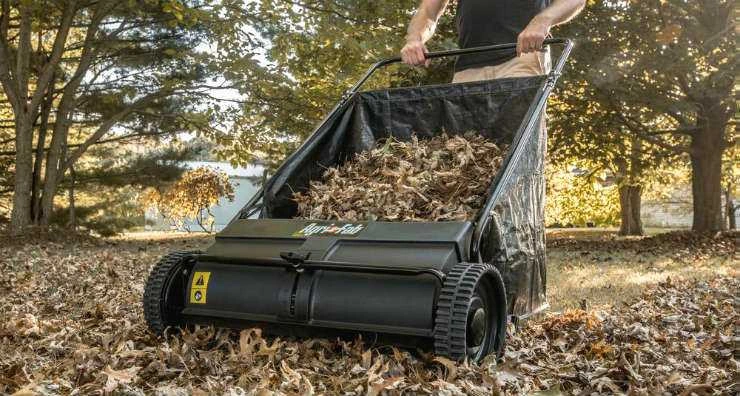
A nice feature about this manual lawn sweeper unit is that it is not tied down to an outlet, allowing a user to operate it anywhere on the property. The 26-inch wide path covers more grass with each pass. Another good feature is that the sweeper folds up, allowing it to be stored easily.
This product requires some assembly but it is simple to use and empty. The collection bag lifts from the body for easy dumping. The poly material used for construction helps to keep weight down.
Best Tow Behind Sweepers: Agri-Fab 45-0492
Pros
- A pull button provides easy height adjustment
- The 44-inch wide pattern covers a lot of ground per pass
- Its hopper can hold 25 cubic ft of material
Cons
- The teeth on the plastic gears may wear with use
- Product assembly can be difficult for first-time users
44
Dethatching Path (inches)
92.6
Weight (lbs)
N/A
Motor (amp)
The first feature that stands out on this product is its minimal 23-pound weight. Shedding unneeded pounds will make this unit easier to push. The height of the tines (the “teeth of the dethatcher) is adjustable with five settings, offering more versatility than other models. The ability to change from a dethatcher to a scarifier allows for cutting at the root level.
A nice safety feature that is incorporated into the design is the safety switch, which may be important for users with younger children. It has four wheels that provide level control.
John Deere Tow-Behind Lawn Sweeper
Pros
- It is able to pick up a variety of debris, including pine needles
- Can connect to motorized products with universal hitches
- The pneumatic tires provide a smooth performance while towed
Cons
- The friction of the metal gears may cause wear on the plastic wheels
- The sweeping action remains active and cannot be turned off
This John Deere tow-behind lawn sweeper product weighs a solid 120 pounds and is easy to assemble after purchase. It performs well, partially due to the pneumatic tires that provide good ground contact across various terrain. The bin is capable of holding up to 24 square-feet of the debris before it requires dumping.
The 11-inch diameter brushes are capable of picking up a variety of materials, including pine cones and needles. John Deere offers a one-year warranty to their customers on this lawn sweeper.
These sweepers attach to a riding lawn mower, ATV, or side-by-side, allowing them to be pulled across a property.
Earthwise LSW70021 21-Inch Leaf & Grass Push Lawn Sweeper
Pros
- Budget-friendly cost
- Customizable sweeping deck height
- Impressive 80% pickup rate in a single pass – fewer passes needed
- Expansive 21-inch sweeping width
- Ample collection bag capacity
Cons
- Manual
If you’re searching for an environmentally friendly choice, the Earthwise lawn sweeper presents an excellent solution for effortlessly sweeping lawns, patios, sidewalks, and driveways. Earthwise is dedicated to creating eco-conscious products to fulfill consumers’ outdoor requirements. In a time of heightened focus on maintaining the cleanliness of our planet, their tools prioritize emission-free operation, contributing to a cleaner Earth.
The Earthwise yard sweeper offers a 21″ brush width, ideal for quick cleanup around your home. Its dual brushes per section efficiently collect debris, covering more ground than a rake or broom in one pass. This sweeper simplifies grass clippings, leaves, and debris cleanup.
The 2.6-bushel leaf collection bag has ample capacity for efficient debris gathering and can be easily attached and removed for mulching, bagging, or composting. The adjustable sweeping height and depth knob enhance versatility, suitable for lawns, patios, sidewalks, and driveways. With a lightweight design, this sweeper is easily maneuverable, and storage is a breeze once your yard work is complete.
Conclusion – The Best Lawn Sweeper and Electric Dethatcher
So, what do we consider the best lawn sweeper out there? This will depend upon what features are required by the homeowner’s current equipment and lawn. If a potential buyer does not currently have an ATV, ZTM, riding mower, or lawn tractor to ride on then a towed lawn sweeper will not be a reasonable purchase. Small and medium-sized yards can be maintained with a push lawn sweeper with minimal physical requirements.
The best lawn sweeper will provide features that make operation easy and efficient. Height adjustment is crucial, as you an operator want to match the height with the grass length. The width of the sweeping brushes will ultimately determine how many passes are needed to cover a yard. One advantage of thinner brushes is their ability to reach less-accessible areas.
Ultimately, a customer’s needs and price-range will determine which lawn sweeper is right for them.
